In the 1990s, scientists discovered a 240-million-year-old amphibian fossil. It is now officially named and described by scientists from the University of New South Wales in Sydney and the Australian Museum.
Initially, fossils were found in stones obtained at a local quarry. The materials are intended for use during the construction of a retaining wall in the garden. But when a fossil was found there, it was donated to the Australian Museum in Sydney. Now reviewed and named Arenaerpeton supinatus, which means “reclining sand creeper”. Nearly the entire skeleton and, remarkably, the outlines of the amphibian skin have been preserved in the rock.
“This fossil is a unique example of an extinct group of animals known as temnospondyls that lived before and during the time of the dinosaurs,” the scientists write. “We don’t often find skeletons attached to the head and torso, and soft tissue preservation is still a rare phenomenon.”
Arenaerpeton lived in freshwater rivers during the Triassic period 240 million years ago. Most likely, he hunted other ancient fish.
Outwardly, the Arenaerpeton is very similar to the modern Chinese giant salamander, especially in terms of head shape. However, scientists conclude that the size of the ribs and the outline of the soft tissues indicate that the ancient animal was many times larger than its modern descendants.














